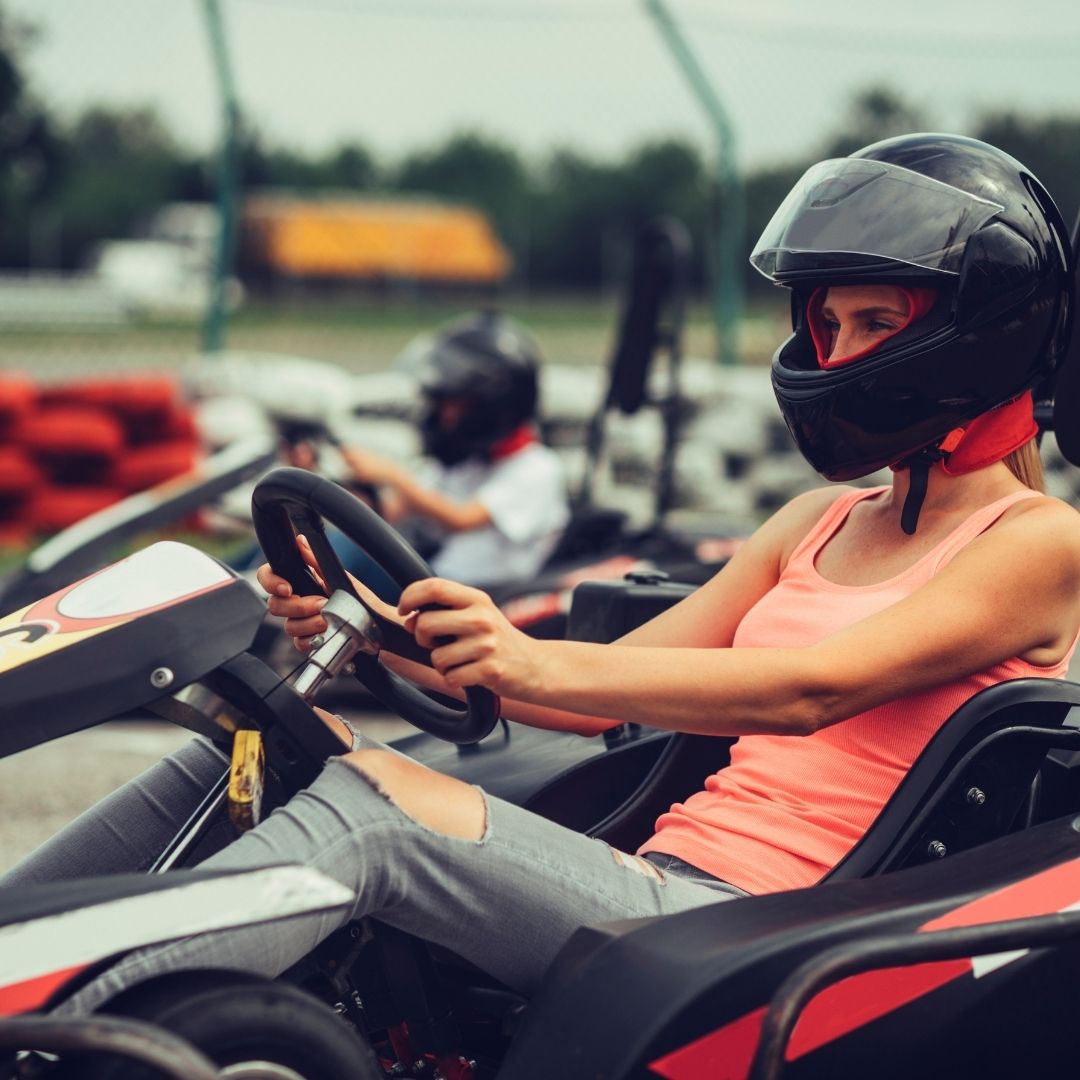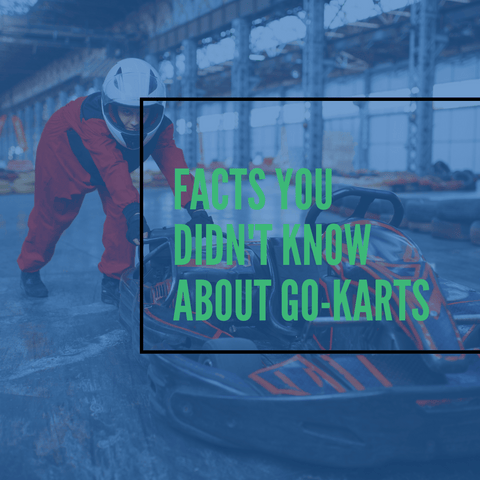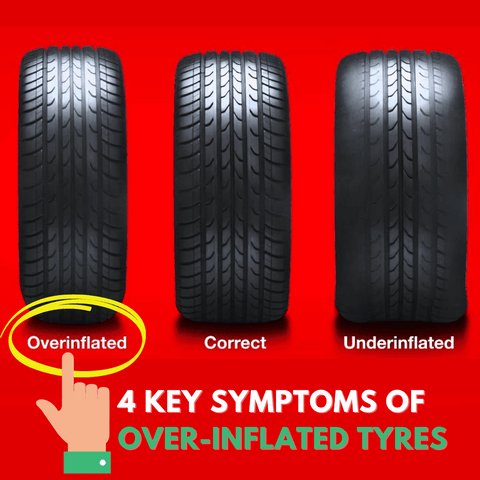Published: 11.5.22
Updated: 22.7.24
You've probably heard about kid's electric ride-on cars, but have you ever considered getting your little one a petrol go-kart?
If you're looking for an exhilarating way to get your child outdoors and active, then a kids petrol go-kart might be just the thing!
In this article, we'll tell you everything you need to know about kid's petrol go-karts, including how they work, the benefits of owning one, and some top tips for choosing the perfect go-kart for your child.
So if you're ready to learn more about these exciting outdoor toys, read on!
What Is A Kids Petrol Go-kart?
A kid's petrol go-kart is a small, four-wheeled vehicle that is powered by an internal combustion engine.
Go-karts typically have a seat that is low to the ground, and they are designed to be driven on smooth surfaces such as pavement or concrete.
While go-karts were originally designed for adults, there are now many different types of go-karts that have been specifically built for kids.
These go-karts usually have smaller engines and lower top speeds than their adult-sized counterparts, which makes them much safer for kids to use.
Related: Ten Facts You Didn't Know About Go-Karts
How Do Kids Petrol Go-Karts Work?
Kid's petrol go-karts work in much the same way as regular go-karts, except that they are powered by petrol instead of electricity.
Petrol go-karts typically have four-stroke engines, which means the fuel does not have to be mixed with oil.
Four-stroke engines are generally more powerful than two-stroke engines, which is why petrol go-karts tend to be faster and more powerful than electric go-karts. However, four-stroke engines also require more maintenance than two-stroke engines, so you'll need to make sure you're prepared to do regular servicing on your go-kart.

Once the engine is running, the go-kart can be driven by using the accelerator and steering controls.
The accelerator is typically located on the right side of the steering wheel, and it is used to control the speed of the go-kart.
The steering wheel is used to turn the front wheels of the go-kart, which allows you to steer it in different directions.
Related: Do Diesel-Powered Go-Karts Exist? (IS IT A MYTH?)
What To Look For When Buying A Kids Go Kart
Different age groups
The faster the go-kart goes the higher the age group it will be suitable for.
Most go-karts have a maximum speed of between 10 and 23 mph, but there are some that can go up to 30 mph.
It's important to make sure you choose a go-kart that is appropriate for your child's age and maturity level, as higher speeds can be dangerous for younger children.
Related: Which Go-Kart Is Most Suitable For My Child?
Different engine sizes
As we mentioned earlier, petrol go-karts typically have four-stroke engines that range in size from 50cc to 250cc.
The size of the engine will determine how fast the go-kart can go, so it's important to choose an engine size that is appropriate for your child.
If your child is very young or inexperienced, it might be a good idea to start with smaller engine size and then move up to a larger one as they become more comfortable with driving.
Related: How Fast Is a 125cc Go-Kart?
Chassis
The chassis of a go-kart is the frame that which the go-kart's body is built on.
There are two main types of chassis that you'll find on kid's go-karts: tubular and plate.
Tubular chassis are typically made from steel or aluminium, and they offer superior strength and durability.
Plate chassis are usually made from fiberglass or composites, and they tend to be lighter in weight than tubular chassis.
Suspension
Most go-karts have some form of suspension, which helps to absorb bumps and shocks when driving on uneven surfaces.
The type of suspension that a go-kart has will usually be determined by the type of chassis it has.
Tubular chassis go-karts typically have coil spring suspension, while plate chassis go-karts usually have shock absorber suspension.
Brakes
All go-karts should have some form of braking system to help you stop safely.
The most common type of brakes used on kids' go-karts is disc brakes, which work by using pads to grip onto a spinning disc to slow down the go-kart.
Some go-karts also have a handbrake that can be used to engage the rear brakes independently from the front brakes.
This can be helpful when making tight turns or if you need to stop quickly.
Safety Features
When choosing a go-kart for your child, it's important to look for one that has some basic safety features.
One of the most important safety features to look for is a roll cage. A roll cage is a frame that surrounds the driver and helps to protect them in the event of a rollover.
Another important safety feature to look for is a seatbelt/harness.
A seatbelt will help to keep your child safely in their seat in case of an accident.
It's also a good idea to choose a go-kart that has adjustable speed settings. This way
Top speeds
Think about has fast you want them to go. Bear in mind that these petrol go-karts can be quite fast.
You'll find that the average go-kart can reach speeds of between 10 and 23 mph.
However, there are some that can go even faster than this. If you're not comfortable with your child driving a go-kart that's capable of reaching high speeds, then it's best to choose one with an adjustable speed setting.
This way, you can set the maximum speed to something that you're more comfortable with.
Related: What is the Fastest Go Kart in the World?
Kids Go-Kart Buying Guide
Choose a go-kart appropriate for your child's age and maturity level.
Consider engine sizes from 50cc to 250cc based on experience level.
Choose between tubular (steel/aluminum) or plate (fiberglass/composite) chassis.
Look for roll cages, seatbelts, and adjustable speed settings.
Consider go-karts with speeds between 10-23 mph, or higher for experienced riders.
Replacement Parts
Depending on where you purchase your go-kart, you might find that replacement parts are available.
If you're planning on letting your child drive their go-kart on a regular basis, then it's a good idea to have some replacement parts on hand, just in case something breaks.
Also, check how much warranty is included.
You'll find that most go-karts come with a one-year warranty, but some have longer warranties of up to two years.
Related: Mastering Go-Kart Transmissions
Storage and Maintenance
Another important consideration is how you're going to store and maintain your go-kart.
Ideally, you should keep your go-kart in a garage or shed when it's not in use.
This will help to protect it from the elements and extend its lifespan.
When it comes to maintenance, you'll need to make sure that you regularly check the engine oil level and tyre pressure.
You should also give the go-kart a thorough cleaning after each use to remove any dirt or debris that could cause problems down the road.
Related: Key Symptoms Of Over-Inflated Tyres
Safety Equipment
Since the petrol go-kart speeds will be much faster than the electric ones, it is important that you purchase safety gear for your child.
This includes a helmet, gloves, and riding boots
You might also want to consider purchasing some protective clothing, such as a race suit or fire-resistant jacket.
Related: Are Electric Go Karts Faster Than Petrol?
Comparing Petrol and Electric Go-karts
When comparing petrol and electric go-karts, both have distinct benefits and drawbacks that can influence a user's choice based on their preferences and requirements.
| Aspect | Electric Go-Karts | Petrol Go-Karts |
|---|---|---|
| Environmental Impact |
|
|
| Performance and Safety |
|
|
| Maintenance and Cost |
|
|
| Performance Limitations |
|
|
| Practical Considerations |
|
|
In summary, electric go-karts offer environmental benefits, safety, and lower maintenance costs, making them ideal for indoor tracks and younger or less experienced drivers.
Petrol go-karts, on the other hand, provide higher speeds, better handling, and longer run times, appealing to more experienced racers and those seeking high-speed thrills.
How To Drive A Go Kart
Posture / Seat Position
Seating
Sit back and relax as soon as you get into the kart. With your legs slightly bent at the knee and your feet just grazing the pedals, a good sitting posture will induce your legs to bend.
To minimise movement in the seat, slimmer drivers may require a cushioned insert. Some karts have adjustable seats and pedals.
Steering
Keep your hands at roughly the ‘quarter to three position' (on either side of the wheel). This utilises your arms' major muscles, allowing for easy pivoting from left to right while minimising strain.
Body positioning
How you sit in your kart can make a big difference to your race times.
Keep your arms slightly bent to maintain control of your vehicle as you slide around corners.
Also, try to keep your body as close to the centre of the kart as possible. This will lower your center of gravity and make the kart more stable
Footwork
When braking and accelerating, use the balls of your feet rather than your toes or heels. This will give you more control over the pedals and help you brake and accelerate more smoothly.
Breathing
This may sound like an odd tip, but it's important to stay relaxed while driving. If you start to feel tense, take a few deep breaths and focus on exhaling slowly. This will help to relax your muscles and improve your concentration
Looking ahead
One of the most important things to remember when driving is to always look ahead. This will help you anticipate upcoming corners and obstacles, and allow you to react more quickly if necessary
Learn the controls
If you learn how to control the petrol go-kart before your kid, it will be much easier to teach them. Each go-kart is different, so it's important to familiarise yourself with the controls before letting your child loose on the track.
Start by learning how to start the engine and how to control the throttle. Then, practice driving around a bit so that you can get a feel for how the kart handles.
Once you're comfortable with the controls, you can start teaching your child how to drive.
Some petrol go-karts have gear shifters, while others are automatic. If your kart has a gear shifter, it's important to learn how to use it properly.
Shift up as you accelerate and shift down when you need to slow down or stop. You should also downshift when going around corners to help keep the kart stable
When you're teaching your child how to drive, it's important to stress the importance of safety. Go over the safety rules with them and make sure that they understand why it's important to follow them.
And, of course, always supervise your child when they're driving to make sure that they're staying safe.
Warm up the tyres
This isn't absolutely necessary, but if you want to get the best possible performance out of your tyres, it's a good idea to warm them up before you start driving.
To do this, simply drive around slowly for a lap or two. This will help to soften the tyres and improve the grip
Slowly build up speed
If you build up speed slowly you get a feeling for the terrain and the kart much better. Sudden movements are more likely to cause you to lose control, so it's always best to take things slowly at first
How to corner
When you're going around a corner, you need to slow down and turn the steering wheel at the same time. The amount that you need to turn the wheel will depend on how sharp the corner is.
As you're turning, keep your eyes focused on where you want to go. This will help you stay on course and avoid obstacles
How to brake
To brake properly, you need to press down on the pedal with your right foot while keeping your left foot hovering over the accelerator.
This will help you avoid skidding or losing control of the kart.
It's also a good idea to practice braking in a straight line before you try it around corners
The Key Legal Aspects
| Key Aspect | Description |
|---|---|
| Road Legality | Petrol go-karts are typically not street legal in the UK. They lack essential safety features and do not conform to public safety regulations necessary for vehicles to be used on public roads. |
| Registration and Licensing | For a go-kart to be considered road legal, it must pass an MOT test and have valid registration and insurance. However, standard go-karts fail to meet the legal criteria for road vehicles. |
| Safety Modifications | To make a go-kart road legal, significant modifications would be required, including the addition of headlights, indicators, windshield, tail lights, and safety belts. Even with these modifications, it's unlikely a go-kart would become road legal. |
| Legal Venues | While public roads are off-limits, go-karts can be legally operated on private tracks, karting clubs, and designated zones in some outdoor recreation areas. |
| Insurance | Various types of insurance are crucial for go-karting:
|
| Licensing for Track Operation | If operating a go-kart track, you may need specific licenses from your local council to run a leisure facility. |
| Environmental Considerations | Go-kart track operators must implement measures to minimise noise pollution and properly manage waste, including the disposal of used tires and oil. |
| Health and Safety | Operators must conduct thorough risk assessments, provide appropriate safety gear, and adhere to Health and Safety Executive (HSE) regulations. |
| Age Restrictions | Competitive racing can start as early as 6 years old in the Bambino class, with different age groups for various classes. |
In summary, while owning and operating a petrol go-kart for personal use on private property or designated tracks is generally legal, using them on public roads is not permitted without extensive modifications and proper registration.
The focus is primarily on ensuring safety and compliance with local regulations when operating go-karts in designated areas.
Comparing the Environmental Impact
When comparing the environmental impact of petrol and electric go-karts, both have distinct effects that can influence a user's choice based on their environmental concerns and requirements.
| Aspect | Petrol Go-Karts | Electric Go-Karts |
|---|---|---|
| Emissions |
|
|
| Noise Pollution |
|
|
| Energy Efficiency |
|
|
| Resource Use and Waste |
|
|
In summary, electric go-karts present a significantly lower environmental footprint compared to petrol go-karts.
They produce zero emissions, are quieter, more energy-efficient, and utilise recyclable components, making them a more sustainable choice for both recreational and competitive karting.
FAQs
Are Kids Petrol Go-Karts Road Legal In The UK?
Kid's petrol go-karts are not road legal and they cannot drive them on the road under any circumstances.
The only place we would recommend letting your kid drive their go-kart is on private land with your supervision.
If you do take them out on the road, not only are you breaking the law, but you're also putting their lives and the lives of other road users in danger.
So, please stick to private land and make sure that there's plenty of space for them to practice driving safely.
Related: Are Go Karts Street Legal?
Can you drive a kid's petrol go-kart on the pavement?
No, under no circumstances should you let your kid drive their petrol go-kart on the pavement.
Not only is it illegal, but it's also incredibly dangerous. There are pedestrians and obstacles all over the place, and if your child hits someone with their go-kart, they could seriously injure them.
So, please stick to private land where there's plenty of space for them to practice driving safely.
What is the minimum age for driving a kid's petrol go-kart?
There is no legal minimum age for driving a kid's petrol go-kart in the UK. However, we would recommend that only children over the age of 8 should be allowed to drive them.
This is because they need to be tall enough to reach the pedals, and they need to have the coordination and strength to control the kart.
Of course, this is at your discretion and you know your child best, so if you think that they're ready to start driving at a younger age, then go for it.
Just make sure that they understand the safety rules and that you always supervise them when they're driving.











Share:
What Kids Ride On Cars are the Fastest in 2025?
Will I Fit In A Go-Kart?